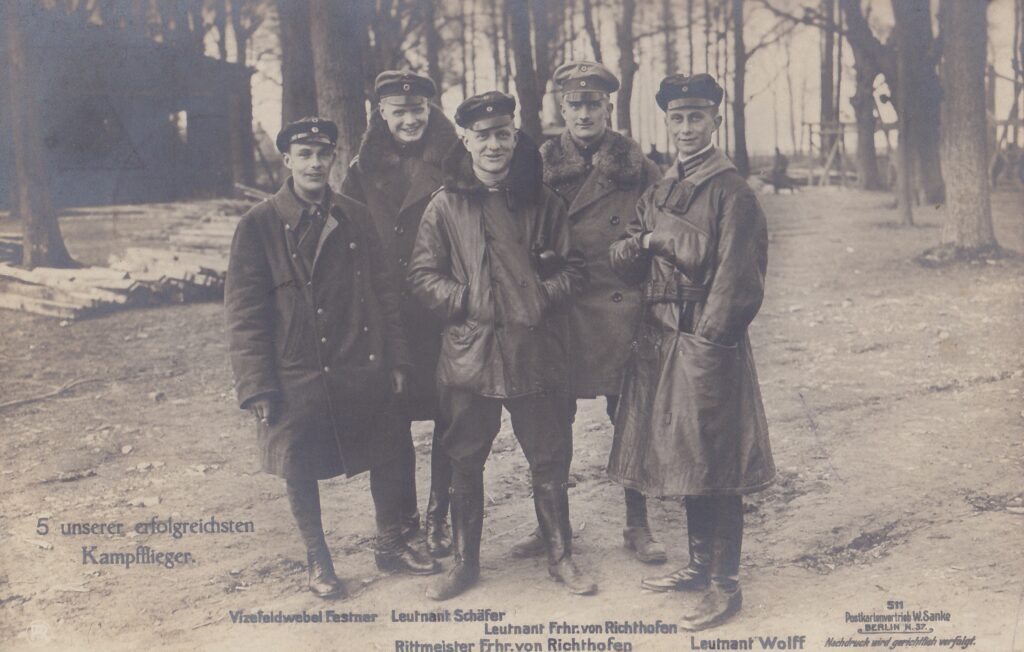21 April marks the centenary of the death of the highest scoring fighter ace of the First World War, Baron Manfred von Richthofen.[1] Known to the French as the Red Devil, because of the colour of his aircraft, it was only years after his death he became known as the Red Baron, (his German title ‘Freiherr’ roughly translates as Baron).

He was born in 1892 to an aristocratic Prussian Military family and at the age of 11 enrolled into military school. Graduating as an Officer candidate in 1911 he joined a Uhlan Cavalry regiment and it was in this capacity that he was first employed during the First World War. He was first sent to the Eastern Front in a reconnaissance position before the regiment was transferred to the Western Front. But the conditions on the Western Front had less requirement of cavalry for this purpose. His regiment spent several quiet months behind the front lines where he was assigned to the quartermaster corps. This did not suit him. He applied to join to the Air Service Division of the German Army and transferred over in May 1915 to train as an observer.
Flying service
His first position in the Air Service was as an observer on reconnaissance missions, again on the Eastern Front. Posted back to France in August, a chance meeting with the German flying ace, Oswald Boelcke, spurred him on to become a pilot. In October that year he began his training. Surprisingly considering his later record, he was not an immediate success at flying. He damaged his plane on landing on his first solo flight, and he failed his first flying exam. He passed his test on 25 December 1915. In March 1916 he learned how to fly the two-seater Albatros, a reconnaissance plane with a maximum speed of 66MPH. However, his appetite for fighter planes had been whetted from his time as an observer.

The turn-around in Richthofen’s career took place in August 1916, when Boelcke was recruiting pilots for his new fighter squadron, Jagdstaffel Nr. 2 (Jasta 2). Boelcke, now the leading ace with 19 victories to his name, remembered the keen Richthofen and asked him to join Jasta 2. Richthofen had been posted back to the Eastern Front at the time. Boelcke later died in October as a result of a collision with another German plane.
Richthofen’s first accredited kill was on 17th September 1916, when he shot down a British FE-2B two seater over Cambrai. To mark the occasion he commissioned a small silver cup to be made. He continued to do this on each such occasion, until he had 60 cups. By that time the domestic supply of silver was dwindling as a result of the naval blockade.
Just after his sixteenth kill he was appointed Commander of Jasta 11 and was awarded the Ordre Pour le Mérite, (the famed Blue Max) the highest German military honour at that time. At this point he arranged for his plane to be painted red. From that point on, his fame in Germany, and notoriety amongst the French and British, only increased. The British formed, what he referred to in his diaries as ‘the Anti-Richthofen Squadron’.
A further change in the war came for him in July 1917, when in an aerial encounter with the Royal Flying Corps, a bullet splintered his skull. He took some time to recover, before returning to his previous flying form. The experience is said to have affected his personality, making him more introspective. In 1918, reflecting on his diary of the war, published in 1917, he said that he was no longer that kind of person.
The death of the Red Baron
By Spring, Richthofen had recovered, and shot down a further 17 planes in March-April 1918, bringing his total number of victories to 80. His final encounter was over the Somme region on 21 April. His squadron of Fokker and Albatros aircraft were engaged in aerial combat with a squadron of RAF Sopwith Camels. During the engagement, when flying at low altitude over British lines, his plane was downed and he was found to have been killed by a single bullet. There is disagreement about who fired this shot, an argument that still continues, but the consensus was that the fatal shot came from the ground.
The plane landed in a sector controlled by Australian forces and was stripped by men seeking souvenirs. He was buried the following day by the Allies with full military honours. The funeral was conducted by the personnel of No. 3 Squadron Australian Flying Corps.
Further reading
TNA AIR 1/682/21/13/220 Information regarding death of Baron von Richthofen
TNA AIR 1/686/21/13/2250 Combat reports of Capt. Baron von Richthofen
[1] The term 'ace' is generally taken to mean any fighter pilot credited with shooting down five or more enemy aircraft
Keep tabs on the past.Sign up for our email alerts.
2 comments
Comment by David Witcher posted on
Although he undoubtedly was the supreme German fighter pilot of WW1 most of his kills were actually unarmed observer corps airships, known as Blimps. Also, unlike the British RFC which spread out their most experienced pilots across many squadrons, the Richthofen Flying Circus was composed of all their top aces including Herman Goering, who then took over the squadron after the Red Baron was killed.
Comment by Tara finn posted on
It is true that the Royal Flying Corps structured their resources differently across its squadrons as opposed to the Jasta 11 concentration of elite pilots. However, Richthofen was not a balloon hunter, and if he ever destroyed any this would not have been included in his 80 combat victories. Downing slower two-seater observer aircraft (not balloons) did not have the glamour associated with dog fights, but was a strategic priority and it was not necessarily easy, as the observers in such aircraft were armed with a machine gun.